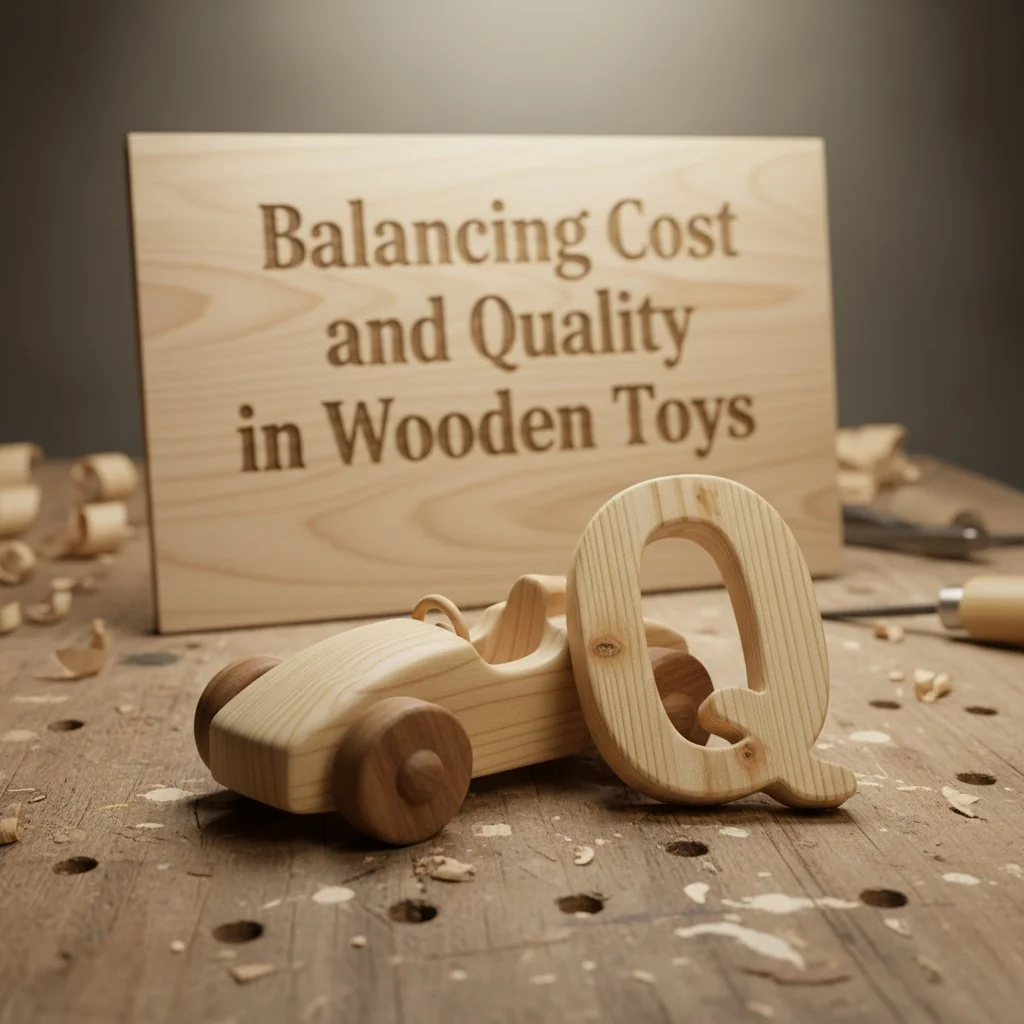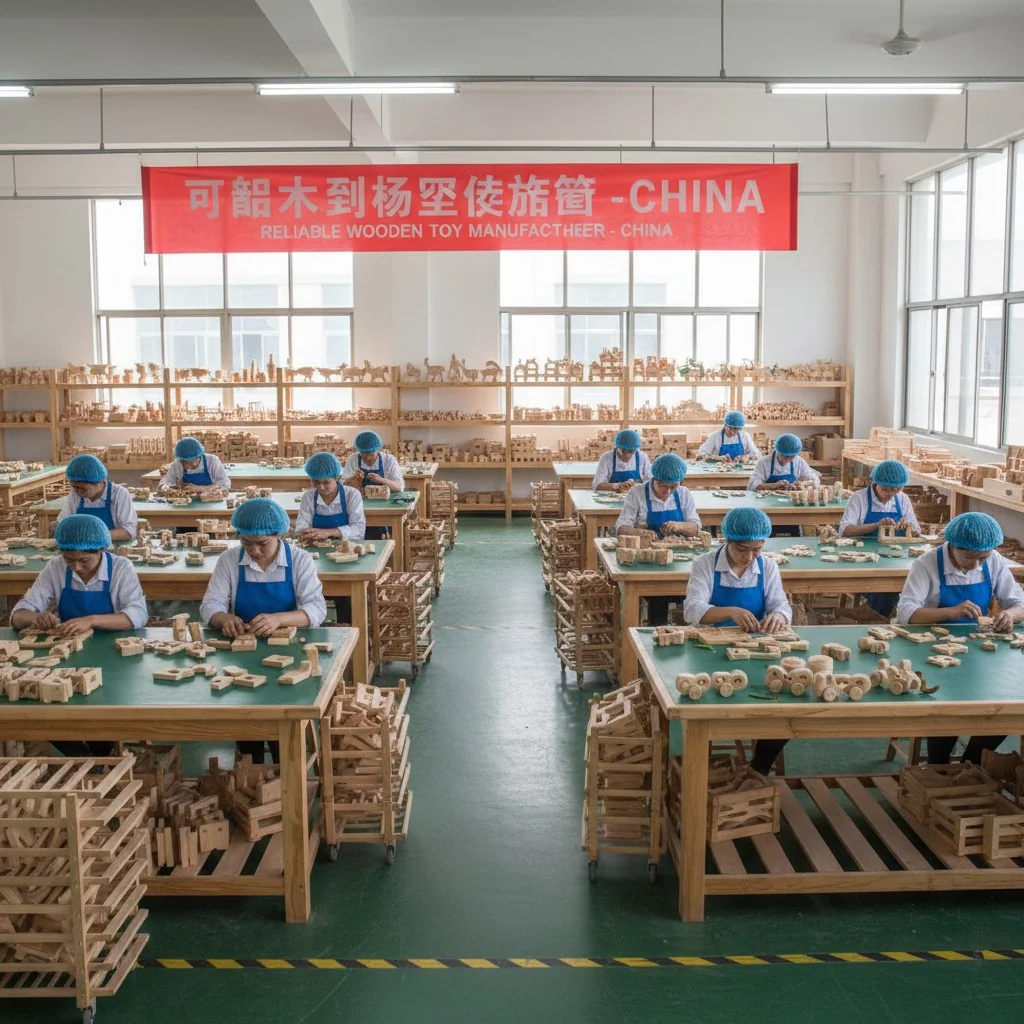
Struggling to choose the right wood for your toy design? The wrong choice can lead to high costs, safety issues, or a product that fails. Let's fix that.
The best material for a wooden toy depends on its use, your budget, and safety needs. Hardwoods like Beech[^1] and Maple offer durability for items like blocks, while softer, cheaper woods like Pine are suitable for decorative pieces. Always prioritize non-toxic, child-safe materials and finishes.

Choosing the right material is one of the first, and most critical, steps in product design. I've seen it countless times in my years in manufacturing, whether it's for a complex plastic mold or a seemingly simple wooden toy. The principles are the same. A designer like you, Jacky, knows that material choice impacts everything: the final look, the feel, the Gwydnwch[^2], and of course, the cost. Get it right, and you have a successful product. Get it wrong, and you're dealing with returns, bad reviews, and budget overruns. Let's break down how to make the right call for your wooden toy project.
All hardwoods are safer for children's toys than softwoods.False
Safety is determined by the wood's splinter-resistance, chemical treatment, and finish, not just its classification. Some softwoods, when properly finished, can be perfectly safe, while some hardwoods can splinter.
Beech wood is a popular choice for children's toys because it is hard, doesn't splinter easily, and has a fine grain.True
These properties make Beech wood durable, safe for children, and easy to finish with non-toxic paints and oils, which is why many major brands use it.
How Do You Balance Cost and Quality in Wood Selection?
Your budget is tight, but you can't compromise on quality. Choosing a cheap wood might save money now, but it could cost you dearly in customer satisfaction and returns later.
The key is to match the wood's cost and properties to the toy's specific function. For high-impact toys, invest in durable hardwoods. For less-handled or decorative items, a more affordable softwood or engineered wood can be a smart, Cost-effective[^3] choice that still delivers quality.

In my trading company, I often advise business starters. One of the first lessons we discuss is the balance between upfront cost and long-term value. It's a universal challenge. I remember a client who wanted to launch a line of premium wooden stacking blocks. They were tempted by the low price of Pine[^4]. I showed them two prototypes: one in Pine, one in Beech. After just a few minutes of handling, the Pine block had dents and chipped corners. The Beech block looked untouched. The visual was powerful. They realized that the higher cost of Beech was an investment in their brand's reputation for quality. We found a supplier who could source Beech wood at a competitive price, which made the decision easier. It's not just about picking the cheapest option; it's about finding the best value for your specific product.
Common Woods and Their Trade-offs
To make the best choice, you need to know your options. Here is a simple breakdown of common woods used in toy manufacturing.
| Math pren | Common Use Cases | Pros | Cons | Relative Cost |
|---|---|---|---|---|
| Beech | Blocks, cars, figures, teethers | Very durable, splinter-resistant, fine grain | Heavier, more expensive than softwoods | High |
| Masarn[^5] | High-end toys, blocks, rattles | Extremely hard, smooth, shock-resistant | Can be expensive, heavy | High |
| Pine | Decorative items, puzzles, larger structures | Lightweight, very affordable, easy to work with | Dents and scratches easily, can have knots | Low |
| Rubberwood[^6] | Eco-friendly toys, furniture, blocks | Sustainable, durable, stable | Can have a less uniform grain pattern | Medium |
| Plywood[^7]/MDF | Puzzles, play kitchens, dollhouses | Cost-effective, stable, won't warp | Can contain formaldehyde (must be certified), edges need sealing | Low-Medium |
Rubberwood is a byproduct of the latex industry, making it an environmentally friendly choice for toys.True
Rubberwood trees are harvested for lumber only after they have completed their latex-producing cycle, making use of a resource that might otherwise be wasted.
MDF (Medium-Density Fiberboard) is always safe for children's toys.False
Standard MDF can contain urea-formaldehyde, a toxic substance. For toys, you must use MDF that is certified as NAF (No Added Formaldehyde) or CARB Phase 2 compliant to ensure it is safe.
Which Woods Are Best for Different Types of Toys?
You've designed a pull-along duck and a set of alphabet blocks. Should they be made from the same wood? Using the wrong material can make a toy too heavy or not durable enough.
Match the wood's characteristics to the toy's function. Use dense, durable hardwoods like Maple or Beech for toys that will be dropped or banged together, like blocks. Use lighter woods like Pine or Plywood for larger items like dollhouses or pull-along toys to keep them manageable for a child.

Thinking about the end-user is everything. A toy isn't just a static object; it's something a child will interact with in very specific ways. For a designer like Jacky, this is second nature. You're already thinking about ergonomics and function. Let's apply that to wood selection. A teething toy, for example, needs to be made from a very hard, close-grained wood like Maple that won't splinter or shed fibers when chewed. It also needs to be completely non-toxic. For a puzzle, the dimensional stability of high-grade Baltic Birch Plywood is perfect because it won't warp, ensuring the pieces fit together perfectly every time. The material choice is part of the design itself.
Functional Material Matching
Let's break this down further. Different play patterns demand different material properties.
For Stacking and Building Toys (e.g., Blocks)
- Primary Need: Durability and weight.
- Best Choices: Beech, Maple.
- Why: These woods resist denting when blocks are inevitably knocked over. Their weight provides a satisfying, stable feel during building, helping children develop fine motor skills. The smooth, hard surface is also easy to clean.
For Wheeled and Pull-Along Toys (e.g., Cars, Animals on Wheels)
- Primary Need: Balance of durability and weight.
- Best Choices: Rubberwood, Pine (for the body), Beech (for wheels).
- Why: The main body can be a lighter wood to keep the toy from being too heavy for a small child to pull. The wheels, however, take a lot of abuse and should be made from a harder wood like Beech to prevent wear and tear.
For Puzzles and Layered Toys
- Primary Need: Dimensional stability.
- Best Choices: High-quality Plywood (like Baltic Birch).
- Why: Plywood is engineered to resist warping and shrinking with changes in humidity. This is critical for puzzles, where even a small change in shape can make the pieces impossible to fit together.
Baltic Birch Plywood is superior to standard plywood for toys because it has more layers and no internal voids.True
This construction makes it stronger, more stable, and gives it a clean, attractive edge that doesn't require finishing, which is ideal for high-quality puzzles and layered toys.
A toy car's wheels and body should always be made from the same type of wood for consistency.False
It's often better to use different woods. A durable hardwood for the wheels ensures longevity, while a lighter wood for the body can make the toy easier and safer for a child to handle.
How Can You Find a Reliable Wooden Toy Manufacturer in China?
You have a great design, but how do you find a factory that can execute it properly? Choosing the wrong partner can lead to poor quality, missed deadlines, and communication nightmares.
Look for a manufacturer with a proven track record, transparent communication, and proper certifications (like ISO 9001, BSCI). Ask for references and samples. A good supplier, especially for a business starter, acts as a partner, offering guidance on materials and design for manufacturability.

This is where my experience in sourcing and manufacturing really comes into play. Finding a good supplier is more than just getting the lowest price. It's about finding a partner. Over the years, I've built a network of trusted factories. For wooden toys, I've worked with suppliers like Tegan woddlon, who supply products for world-famous brands. What makes them reliable? First, they understand the specific Safety standards[^8] for different markets, like EN-71 in Europe and ASTM F963 in the US. Second, they are willing to work with new businesses, providing feedback on designs to make them more efficient to produce without sacrificing quality. They know the materials. You can give them a design, and they can immediately suggest the most suitable wood based on your target cost and quality level. This kind of expertise is invaluable and saves you from costly mistakes.
Vetting a Potential Supplier
Here is a checklist I use when evaluating a new manufacturing partner.
- Certifications: Do they have quality management (ISO 9001) and social compliance (BSCI) certifications? Can they provide safety testing reports (EN-71, ASTM) for their materials and finishes?
- Experience: Who are their other clients? If they are supplying major, reputable brands, it's a good sign. Don't be afraid to ask for references.
- Sample Process: How do they handle samples? A good factory will have a clear, structured process for creating and revising prototypes. You should always get a final production sample approved before starting a mass run.
- Communication: Are they responsive and clear in their communication? Language barriers can be managed, but a lack of transparency or slow responses is a major red flag.
- Factory Audit: If possible, visit the factory or hire a third-party service to conduct an audit. This gives you a clear picture of their capabilities, working conditions, and quality control processes.
A BSCI (Business Social Compliance Initiative) audit report guarantees a factory produces high-quality products.False
BSCI focuses on social compliance, such as fair labor practices and workplace safety. While often correlated, it is not a direct measure of product quality, which is better assessed by ISO 9001 certification and product-specific testing.
Requesting a 'Golden Sample' is a critical step before mass production.True
The 'Golden Sample' is the final, perfect prototype approved by you. It serves as the benchmark against which all mass-produced units will be compared, ensuring quality control and consistency.
Conclusion
Selecting the right wood and a reliable supplier are key to success. By matching materials to function and thoroughly vetting partners, you create safe, high-quality, and profitable wooden toys.
References
[^1]: Beech wood is durable, splinter-resistant, and safe for children, making it a top choice for toy manufacturers.
[^2]: Durability is crucial for toys that endure rough play, impacting safety and longevity.
[^3]: Understanding cost-effective woods helps balance budget constraints with quality in toy production.
[^4]: Pine is lightweight and affordable, but it can dent easily, making it suitable for decorative items.
[^5]: Maple's hardness and shock resistance make it ideal for high-end toys, ensuring longevity and safety.
[^6]: Rubberwood is a sustainable choice, utilizing trees after their latex production cycle, reducing waste.
[^7]: Plywood's stability and resistance to warping ensure that puzzle pieces fit together perfectly over time.
[^8]: Compliance with safety standards like EN-71 and ASTM F963 is essential for ensuring children's safety.
